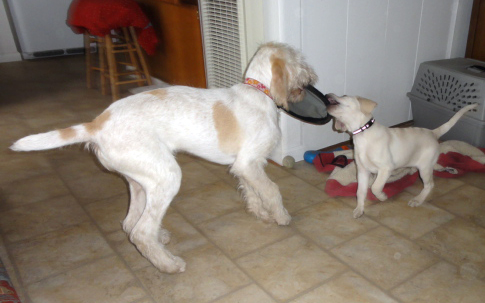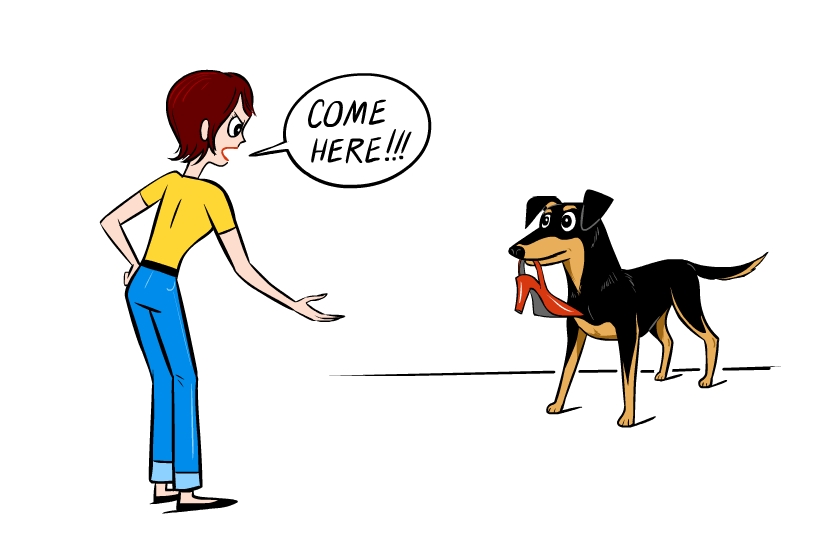
Two young pups playing with an appropriate toy while supervised. Photo by Jill Breitner
Puppy chewing is the biggest complaint of any new puppy guardian.
Destructive behavior in puppies is not necessarily part of puppyhood. I am always surprised to hear puppy guardians say that they can’t wait to get out of the puppy destruction phase. If you set your puppy up to win, you will never have to succumb to this myth about puppies and you will enjoy your puppy, that much more.
In the domestication of dogs, we tend to forget their natural, normal and instinctive needs, thereby, creating situations where the dog fails to meet our standards within the confines of living in our homes, not their natural state.
What is the difference in the puppy’s mind between a tree limb and a wooden table leg? Why does your puppy drag your socks or under garments to their bed and sleep on them? Is she being destructive or trying to have your scent as close as possible, akin to sleeping next to mom or in a puppy pile? When they bring you a stick from the forest for you play chase or fetch or your shoe; are they trying to be destructive, dominant or invite you to a game of chase? If you can try to see it from a puppy’s point of view, you’ll be in a lot better shape to raise and train your puppy to choose appropriate toys, ensuring a destructive free puppyhood.
Dogs do need to chew, even more so when they are teething but teething is over by 6 months of age. People complain of teething and destruction well into maturity. Puppy chewing is normal, yet destructive chewing is NOT synonymous with puppyhood. When you realize how to manage puppies, you will never have to go through the destruction phase again.

Diamond, the star of the Dog Decoder smartphone app is asking for a game of fetch. He’s not being dominant or destructive. Illustration by Lili Chin
The key to a joyful puppyhood is pretty simple. You only need to follow these three simple steps. Supply appropriate toys, exercise and a training program. Meeting your puppy’s needs with physical and mental stimulation and tons of toys, you won’t ever need to replace a shoe, a remote control or your socks… again!
Follow these 4 simple steps
1- Exercise: Puppies need exercise, physical stimulation. This means that they need to have at least two walks a day. Providing them with walks not only gives them physical stimulation, it also provides mental stimulation, and it satisfies their basic instinct and strongest sense; smell! It’s what dogs do best and that is SNIFF. Watch the video below to find out why this is so important. In addition to walks, providing your puppy with an exercise routine of playing with other friendly dogs, going someplace safe off leash where he can be a dog, sniff, socialize, chase butterflies, climb over logs, run up hills, play fetch, etc; will leave him too tired to be destructive. Remember, puppies also need adequate rest, so don’t over do it. More is not better.
2- Train: Puppies need to be mentally stimulated by training with tricks, games and obedience cues such as SIT, STAY, DOWN, COME, right from the start. The minute you bring your puppy home at 8 wks of age, teaching begins. A dog left alone in your home or in a backyard unsupervised, can wreak havoc by digging, destroying furniture, pulling up drip lines, etc. If they are bored mentally and physically and have no guidance or choices for stimulation, they can become destructive. So, offering enrichment activities and exposure to the world, leaves a puppy satisfied and tired. During the first four months of life, puppies should meet 100 faces in 100 days. That is people and animals of all sizes and ages. Veterinarians now agree that it is critical for puppies to be socialized early, before they are 4 months of age and yes, before they are fully vaccinated. You can socialize your puppy with family and friends, friendly dogs in your home or theirs but don’t go to public dog parks, where the possibility of contracting disease or unfriendly dogs, exists. Proper socialization is critical and should be part of your training program.
3- Satisfy your dogs need to chew.
Chewing is natural and necessary for puppies. They get to know their world by smelling and mouthing pretty much anything that is in their path. Puppy proof (#4 below) your home from dangerous things and keep plenty of toys, puzzle games and comfort fluffy toys and your don’t won’t be looking for things because the supply is abundant. Supplying appropriate toys for them to chew on is essential in raising puppies. A puppy begins teething at approximately 4 months of age and finishes with a new set of adult teeth by 6-7 months of age. During the teething phase they may want to chew more, due to the pain. If a dog is destructive after 6 months of age, she is not teething any longer; it has become a chewing and/or destructive habit/problem. Offering appropriate things to chew on and play with is part of teaching them, what is theirs and what’s not. Ice cubes also help during the teething phase and they love them.

4 month old Aussie pup enjoys toys in his bed. Photo by Jill Breitner
Supply appropriate toys
Setting your puppy up to win by supplying and encouraging chewing on appropriate toys to satisfy their chewing needs.
I suggest that you have at least 10-15 toys for the puppy to chew on and play with. Spending $100 on dog toys and games is far less expensive than replacing your shoes, remote control or your couch. If you don’t supply toys, your puppy will have no choice but to find his own toys, to chew on and I can assure you, that these will not be things you will want him to have. Keep toys available at all times, everywhere the puppy is. Switch out toys to offer novelty. This goes a long way in abating boredom; works wonders.
Toys have different purposes
- Squeaky toy (interactive and teething toy, before adult teeth come in)
- Fluffy toy (acts as a littermate, for comfort in crate or confined space)
- Nylabones (chew and interactive)
- Ball (interactive) unless it’s a rubber ball or kong. Tennis balls are not a chew toy.
- Rope toy (teething chew before adult teeth come in and interactive)
- Homemade toys, i.e. plastic water bottle (cap removed), interactive; clean socks that don’t have matches, tied in knots are similar to the rope toys. You can make a big long knotted sock toy, or put a ball in one end, tie it in a knot or make a big round knotted sock toy. How creative can you get? Just make sure it’s safe. (interactive)
- Marrow bones from the butcher (chew toy)
- Antlers: (chew toy)
Only leave safe chew toys with your puppy when he is alone and the others for when you are playing/interacting with him. If you have a dog that destroys certain toys, then these are not appropriate for this puppy. You’ll need to offer non-destructive toys to alleviate the danger of the pup swallowing parts of a toy, they’ve destroyed.
#4 Puppy proof your home.
- Remove all things dangerous or valuable.
- Remove things at puppy level, i.e. magazines in a rack or on lower shelves.
- Close all doors to rooms you’re not using.
- Confine puppy to the room you are in, not allowing them free run of the house.
- Confine the puppy in a crate, exercise pen or room when there is no one available to supervise the puppy.
- The only things left on the floor should be his toys. You may leave your shoes on the floor, but in the same place, (in your closet, by the front door, in the mud room, etc.) so you can teach the puppy that shoes are off limits by redirecting him to his toys.
- Baby toys and dog toys can look very similar to puppies, so it’s important for the puppy to have his own toys, in his own area so that he may learn what are his and what’s not. Pick up after the children, especially toys that are small, potentially life threatening to a puppy.
- Bundle electrical wires, making them unaccessible.
Setting your puppy up to WIN is easy with these 4 simple steps. Remember, puppy chewing is normal but destruction is not.
Happy Puppyhood.
About the author: Jill Breitner, is a professional dog trainer and dog body language expert loving and living her life on the west coast of the USA. She is the author of Dog Decoder, a smartphone app about dog body language recommended and used by veterinarians, shelters, trainers, educators and guardians worldwide and available in iTunes and Google play. Jill has been teaching gentle handling/basic husbandry skills to clients and their dogs for 40 years, to be your pets advocate for a happier and stress free life. Join Jill on her Dog Decoder Facebook page


